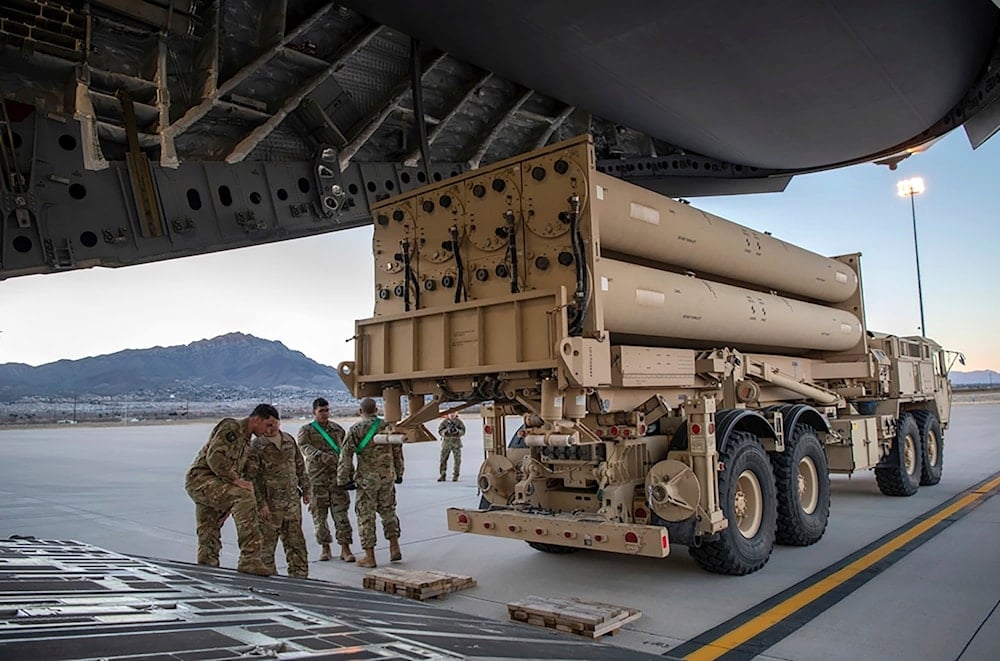Pentagon seeks $3.5bln to replenish stocks after Israeli war on Iran
The Pentagon plans to allocate over $3.5 billion in emergency funding to restock missile interceptors and cover operational costs after the war on Iran, with a major portion tied to SM-3 and THAAD systems.
-

US Army Terminal High Altitude Area Defense (THAAD) launching station preparing to load onto a 4th Airlift Squadron C-17 Globemaster III at Fort Bliss, Texas, on February 23, 2019. (Staff Sgt. Cory D. Payne/US Air Force via AP)
The Pentagon is planning to spend over $3.5 billion to replenish military inventories and sustain operations in West Asia, following "Israel's" recurrent operations, Bloomberg reported on Tuesday, adding that budget documents prepared through mid-May detail the costs associated with heightened military activity in the region, primarily stemming from the April 2024 Iranian retaliatory missile strike and its aftermath.
Labeled as "emergency budget requests," the allocations cover both advanced weaponry and routine logistical needs. These include replenishing interceptors, maintaining radar systems, refurbishing naval vessels, and transporting munitions.
The report details that a significant portion of the emergency funds is earmarked for restocking missile interceptors used during Iran's retaliatory Operation True Promise 1, including at least $1 billion directed toward RTX Corp.’s Standard Missile series, especially the advanced "SM-3 IB Threat Upgrade" variant.
It is worth noting that each interceptor costs between $9 million and $12 million and was used by US Navy ships to defend Israeli targets. Additionally, $1.4 million is allocated to cover the cost of a special transport mission delivering new SM-3 IB rounds from the US to an undisclosed location.
The Bloomberg report mentions that two US Navy Aegis missile defense destroyers, the USS Arleigh Burke and the USS The Sullivans, operating in the Eastern Mediterranean, were among the units that fired SM-3 missiles in defense of "Israel", according to US officials. The effort was bolstered by a land-based Army unit that deployed Terminal High Altitude Area Defense (THAAD) interceptors against incoming Iranian ballistic missiles.
The funding requests stem largely from the response to Iran’s April 2024 response to the Israeli aggression on its land, which included more than 110 medium-range ballistic missiles, at least 30 land-attack cruise missiles, and over 150 uncrewed aerial vehicles. The scale of the attack prompted an extensive US military response aimed at supporting "Israel".
US Central Command cites high operational costs
According to Bloomberg, the budget documents justify the expenditures as necessary to offset costs incurred by the US Central Command. These costs are associated with both military actions and operations conducted "at the request of or in coordination with Israel" during the Iranian retaliatory attack.
The single-largest replenishment request involves around $1 billion for RTX’s Standard Missile interceptors. These were extensively used during April’s coordinated missile defense operations and are deemed essential for future readiness in the region.
The second-largest allocation, $204 million, is designated for acquiring additional THAAD missile interceptors produced by Lockheed Martin Corp. Each unit carries a production cost of approximately $12.7 million.
Another $9.2 million is requested to address deferred maintenance for the THAAD system’s TPY-2 radar. This includes replacing eight Prime Power Unit engines and alternators, following unplanned wear and tear due to a newly disclosed THAAD deployment at an unspecified location.
According to the report, the Pentagon’s financial plans reflect a sustained US military commitment in West Asia, particularly in support of "Israel" amid heightened regional tensions. While separate from the $4.2 billion in arms and equipment transferred to "Israel" between October 2023 and May 2024, this latest request underscores the long-term costs of US involvement in regional operations.

 3 Min Read
3 Min Read










